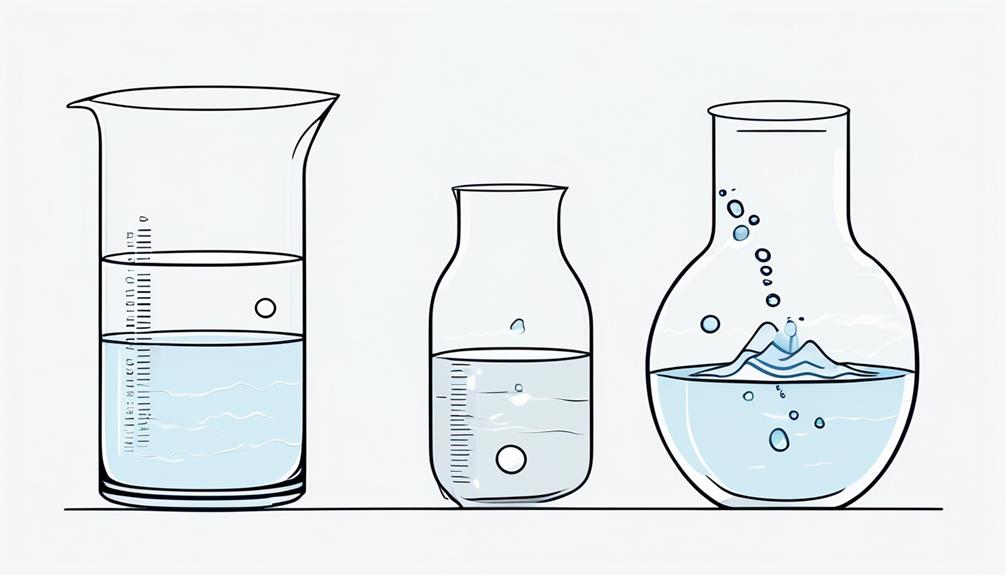When it comes to the clarity of your drinking water, adhering to turbidity standards plays a vital role. Have you ever considered how suspended particles and contaminants in water can impact its quality and safety?
Understanding the significance of turbidity levels in your water supply is not just about what you see but also about what you can't see that might be lurking within. By delving into why drinking water turbidity standards are essential, you'll uncover a world where transparency is key to safeguarding both your well-being and the environment.
Key Takeaways
- Turbidity levels directly impact water treatment plant efficiency and drinking water quality.
- Monitoring turbidity is essential to ensure safe and clean drinking water for public health.
- Adherence to recommended turbidity standards, such as levels below 1 NTU, is crucial for safeguarding water quality.
- Controlling turbidity levels not only enhances water taste, odor, and appearance but also protects aquatic life and overall water quality.
Importance of Turbidity in Water Quality
Understanding the impact of turbidity on water quality is crucial for ensuring safe and clean drinking water for communities. Turbidity refers to the cloudiness or haziness of water caused by suspended particles such as sediment, silt, and organic matter. High turbidity levels can affect the efficiency of water treatment plants and the quality of drinking water. The Environmental Protection Agency (EPA) has set specific water quality standards regarding turbidity to protect public health and the environment.
In the drinking water industry, monitoring turbidity is essential to improve water quality and ensure that water filtration and treatment processes are effective. Excessive turbidity can interfere with disinfection processes, allowing harmful pathogens to survive and potentially cause waterborne diseases. By controlling turbidity levels, water treatment plants can produce cleaner and safer drinking water for the public. Prioritizing turbidity management is a key aspect of maintaining the integrity of water systems and safeguarding public health.
Significance of Turbidity in Drinking Water
To grasp the importance of turbidity in drinking water, consider how it impacts the quality and safety of the water you rely on every day.
Turbidity refers to the cloudiness or haziness caused by tiny particles suspended in water. These particles can include sediments, pathogens, and contaminants. Monitoring turbidity is crucial as it gives insight into the presence of these harmful substances, affecting both human health and water treatment efficiency.
The level of turbidity in water not only influences its appearance but also its taste and odor, directly impacting its suitability for safe drinking. High turbidity can harm aquatic life and overall water quality.
Measurement of Turbidity in Drinking Water
When measuring turbidity in drinking water, you'll explore different methods to assess clarity and purity.
Clear water is crucial as it indicates lower levels of suspended particles and contaminants.
Understanding these measurements ensures your water is safe and clean for consumption.
Turbidity Measurement Methods
For accurate measurement of turbidity in drinking water, a turbidimeter is commonly employed. Turbidity levels are crucial in determining water quality. Turbidity is measured using this device, ensuring that drinking water meets safety standards. The turbidimeter provides a quick and precise way to measure turbidity levels.
In some cases, a Secchi disk, a simple tool lowered into the water, can also be used to estimate turbidity. Standards recommend turbidity levels below 1 NTU for safe drinking water, while developing countries often aim for levels below 5 NTU. Monitoring turbidity is essential to guarantee that the water is free from harmful particles and pathogens, safeguarding public health.
Importance of Clear Water
The clarity of drinking water is a critical indicator of its quality, directly linked to the measurement of turbidity. Turbidity indicates suspended sediments, pathogens, and contaminants, impacting water quality. High turbidity can harm aquatic life, making it essential for monitoring and maintaining water cleanliness. Turbidity levels affect water appearance, taste, and odor, ensuring safe drinking water. Filtration systems are crucial to reduce turbidity levels and provide clear drinking water.
Clear water is vital for various reasons: Ensuring safe drinking water free from harmful contaminants. Maintaining water quality standards for health and environmental concerns. Preserving aquatic ecosystems by minimizing turbidity levels. Enhancing the efficiency of disinfection processes to safeguard public health.
Turbidity's Role in Industrial Processes
In industrial processes, turbidity plays a crucial role by determining the quality of products.
Turbidity measurement methods are employed to ensure consistency and purity in beverage manufacturing.
Monitoring turbidity levels is essential for maintaining the desired quality standards in various industrial settings.
Industrial Process Impact
Ensuring optimal product quality and integrity in industrial processes relies heavily on accurate turbidity measurement and management.
- Plant operators need to monitor turbidity levels to maintain product quality standards.
- Presence of suspended solids can affect the efficiency of the water treatment process.
- Measuring turbidity helps in controlling the level of turbidity in the industrial processes.
- Managing turbidity is crucial for removing suspended solids and ensuring the quality of the final product.
Turbidity Measurement Methods
Monitoring turbidity levels in industrial processes is a critical aspect of ensuring product quality and integrity. Turbidity measurement methods play a key role in maintaining high standards. Turbidity is measured in NTU (Nephelometric Turbidity Units) using instruments like turbidity meters that detect the presence of suspended particles in liquids.
Filtration processes are often employed to reduce turbidity levels. In industries such as beverage manufacturing, turbidity is crucial for maintaining the clarity of products like beer and wine. One common method for visual turbidity assessment is the Secchi disk, which measures water turbidity based on the depth at which the disk becomes invisible.
These methods are essential for controlling and optimizing product quality in various industrial processes.
Turbidity Impact on Fish and Organisms

Turbidity's impact on fish and organisms becomes evident through its negative effects on their habitats and health.
- High turbidity levels can affect fish gills, making it harder for them to breathe.
- Suspended particles in turbid water can disrupt fish habitats, affecting their natural behavior and movement.
- Turbidity alters fish growth, potentially stunting their development and reproductive capabilities.
- Increased turbidity can lead to the spread of waterborne diseases among aquatic organisms, impacting their overall population.
Understanding how turbidity influences aquatic life is crucial for maintaining water quality and ensuring the well-being of fish and other organisms. By measuring turbidity levels, often done using tools like a Secchi disk, scientists and environmentalists can monitor and manage turbidity to safeguard the water supply and protect the delicate balance of aquatic ecosystems.
Turbidity's Influence on Plants and Animals
High levels of turbidity in water can have detrimental effects on both aquatic plants and animals, impacting their growth, behavior, and overall well-being. For plants, high turbidity levels reduce the light that reaches them, hindering photosynthesis and growth. This can lead to stunted development and decreased reproduction rates.
Aquatic animals also suffer as increased turbidity disrupts their feeding and breeding behaviors, affecting the delicate balance of ecosystems and food chains. Sediment-laden water, a result of high turbidity, can smother and stress aquatic organisms, jeopardizing their health and survival.
Furthermore, turbidity alters oxygen levels, impeding the respiration of aquatic creatures and potentially causing suffocation in extreme cases. The presence of excessive turbidity also hampers the filtration capabilities of some aquatic organisms, impairing their ability to feed and thrive.
Methods for Turbidity Measurement

To accurately measure turbidity levels in water, a turbidimeter is commonly utilized along with recommended standards advocating for levels below 1 NTU. Ensuring water is clear of suspended particles is crucial for safe drinking water.
To measure turbidity effectively, consider the following methods:
- Turbidimeter: This device measures the amount of light scattered by particles in the water, providing a quantitative turbidity value.
- Secchi disk: A simple tool consisting of a black and white disk lowered into the water; the depth at which it disappears indicates turbidity levels.
- Light-based Methods: Using light to gauge the presence of particles in water helps in monitoring and maintaining water quality standards.
- Industrial Monitoring: Turbidity meters are also essential for monitoring suspended particle concentration in industrial processes, ensuring efficiency and compliance.
Understanding Turbidity Standards
Understanding the importance of adhering to turbidity standards is essential for ensuring clean and safe drinking water. Turbidity standards set the guidelines for the acceptable level of cloudiness in water. Monitoring turbidity is crucial as it indicates the presence of particles in the water that can affect its quality. To adhere to these standards, water treatment facilities use filtration and disinfection processes to remove impurities.
When monitoring turbidity, water samples are taken and analyzed using instruments like a Secchi disk, a simple tool that measures water clarity. This helps ensure that the water meets the required standards before being distributed for consumption. By maintaining proper turbidity levels, water and wastewater facilities can prevent harmful substances from entering the drinking water supply.
Achieving and maintaining the set turbidity standards is vital for safeguarding public health and the environment. It ensures that drinking water is free from contaminants and safe for consumption. Adhering to these standards is a critical step in providing high-quality drinking water to communities.
Implications of Turbidity in Water Systems

When considering the implications of turbidity in water systems, it becomes evident that suspended sediments and contaminants can significantly impact both aquatic life and water quality.
Here are some key points to illustrate the importance of monitoring and managing turbidity:
- Turbidity indicates the amount of light scattered in water, affecting the clarity and quality of drinking water.
- High turbidity levels can hinder the effectiveness of water treatment processes, potentially leading to unsafe drinking water.
- Monitoring turbidity with turbidity meters is essential for ensuring safe drinking water and assessing the efficiency of water treatment.
- Excessive turbidity can harm aquatic life by disrupting fish habitats, impeding their movement, and affecting their overall health and growth.
Frequently Asked Questions
Why Is Turbidity Important in Drinking Water?
Turbidity matters in drinking water because it shows how clear or cloudy the water is. High turbidity can mean more particles, bacteria, or chemicals are present. Clear water is safer to drink. Check turbidity for clean water.
Why Are Water Quality Standards Important?
Water quality standards are vital for safeguarding public health. They ensure that drinking water meets safety requirements, preventing illnesses caused by contaminants. By adhering to these standards, you can trust in the purity of your water supply.
What Is Turbidity's Major Danger in Drinking Water?
In your drinking water, high turbidity can hide harmful pathogens, making disinfection less effective. This raises the risk of waterborne illnesses. Clear water is essential for safety and taste. Monitoring turbidity levels is key.
Why Is Turbidity an Important Water Quality Measurement for the Disinfection Process?
Wonder why turbidity matters in water disinfection? Well, high levels can hinder the process, shielding pathogens. Monitoring and adjusting are key to meet safety standards, ensuring clean drinking water. Turbidity serves as an efficiency indicator.
Conclusion
As you dive into the world of drinking water turbidity standards, remember that they're like the shining beacon guiding us to clean and safe water.
Just as a lighthouse illuminates the path for sailors in the dark, turbidity standards illuminate the way to healthy hydration.
Let's keep our waters clear and sparkling, like a pristine gem in the sea, by upholding these important standards for the well-being of all.
